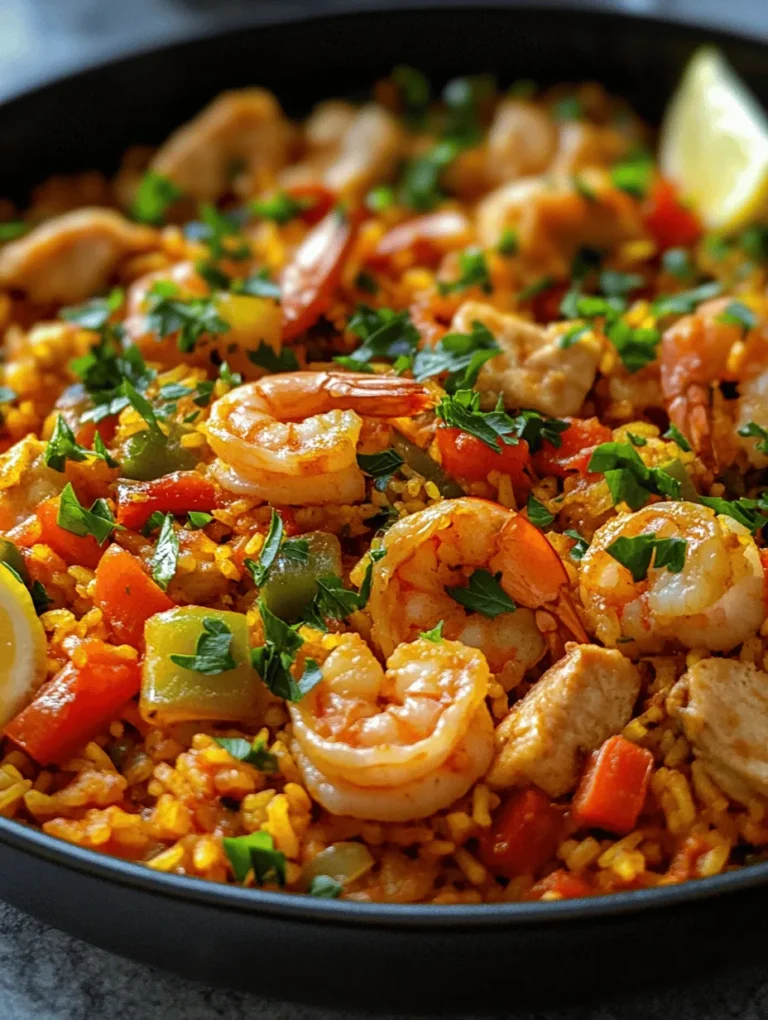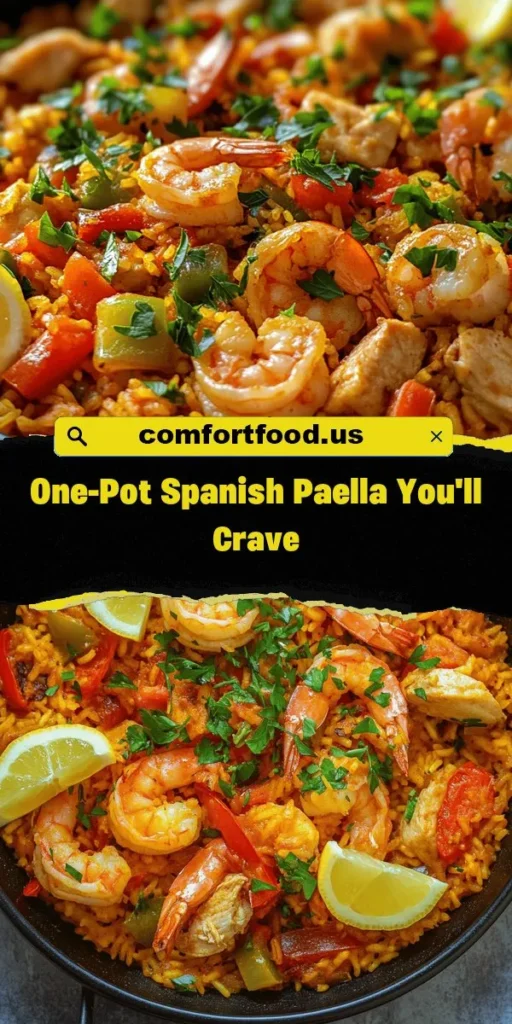Introduction
When it comes to iconic dishes that represent the heart and soul of Spanish cuisine, One-Pot Spanish Paella stands out as a vibrant and flavorful choice. Originating from the sun-kissed region of Valencia, paella is a dish that has captured the hearts and taste buds of food lovers around the world. This one-pot wonder is not only a feast for the senses, with its colorful presentation and aromatic spices, but it also embodies the spirit of communal dining that is deeply rooted in Spanish culture.
Paella is more than just a meal; it is a celebration of togetherness, often enjoyed during family gatherings and festive occasions. The beauty of a one-pot paella lies in its convenience—allowing cooks to prepare a delicious and hearty meal without the need for multiple pots and pans. With a few simple steps, you can create an impressive dish that is sure to impress your guests, making it the perfect choice for a cozy family dinner or a lively gathering among friends.
The Allure of Paella
History of Paella
The history of paella is as rich and colorful as the dish itself. Its origins can be traced back to the mid-19th century in the Valencia region of Spain, where it was traditionally cooked by farmers and laborers who would use local ingredients sourced from the nearby fields and shores. The word “paella” comes from the Old French word “paelle,” meaning “pan,” which refers to the shallow, flat pan used to cook this iconic dish.
Over time, paella has evolved into numerous regional variations, each showcasing distinctive ingredients and flavors. The most traditional version, known as “paella Valenciana,” typically includes chicken, rabbit, green beans, and saffron-infused rice. However, as the dish gained popularity beyond Valencia, it began to incorporate a variety of ingredients, such as seafood, which is now commonly found in coastal versions. This adaptability has allowed paella to become a symbol of Spanish cuisine, embraced by chefs and home cooks alike.
Traditional Ingredients and Variations
One of the most appealing aspects of paella is its versatility. While the classic ingredients form the foundation of the dish, variations abound across different regions of Spain. In coastal areas, you may find seafood paellas loaded with shrimp, mussels, and calamari, whereas inland versions might feature hearty meats like chicken and chorizo.
The communal aspect of dining is also integral to the paella experience. Traditionally, paella is cooked outdoors over an open flame, allowing family and friends to gather around the pan as it bubbles and steams. This shared experience is not only about enjoying delicious food but also about creating lasting memories with loved ones.
Essential Ingredients for Your One-Pot Paella
Creating a mouthwatering one-pot paella requires carefully selected ingredients that come together to create a symphony of flavors. Below, we will delve into the essential components that define this beloved dish, highlighting their unique contributions to the overall taste and presentation.
Olive Oil: The Base of Flavor
Olive oil is the cornerstone of Spanish cuisine, and it plays a pivotal role in the flavor profile of paella. Not only does it provide a rich and fruity base for sautéing the aromatics, but it also adds depth and authenticity to the dish. When choosing olive oil, opt for extra virgin varieties for their superior taste and health benefits.
Onion and Garlic: Aromatics that Enhance the Dish
Onion and garlic are the aromatic duo that forms the backbone of many traditional Spanish dishes, including paella. The sweetness of sautéed onions, combined with the pungency of garlic, creates a fragrant foundation that enhances the overall flavor. These ingredients infuse the rice with a savory essence, making each bite more delicious.
Bell Peppers: Color and Sweetness
Adding bell peppers to your paella not only brings a pop of color but also contributes a subtle sweetness that balances the dish. Whether you choose red, green, or yellow peppers, their crisp texture and vibrant hues will make your paella visually appealing and flavorful.
Smoked Paprika: Key Seasoning for Authenticity
No Spanish dish would be complete without the distinctive flavor of smoked paprika, or “pimentón.” This spice is made from dried and smoked red peppers, lending a unique depth of flavor to your paella. Its earthy, smoky notes are essential for achieving the authentic taste that defines this classic dish.
Saffron: The Luxurious Spice That Defines Paella
Saffron is often regarded as the crown jewel of paella. This precious spice, derived from the Crocus sativus flower, imparts a beautiful golden hue and a delicate, floral flavor that is unmistakable. While saffron can be pricey, a little goes a long way, and its inclusion elevates your paella from ordinary to extraordinary.
Arborio Rice: Choosing the Right Type for Texture
The type of rice you use for paella is crucial to achieving the perfect texture. Arborio rice, known for its short, plump grains, is an excellent choice as it absorbs liquids well while retaining a slight bite. This characteristic is essential for creating the creamy, rich consistency that paella is known for. Alternatively, you can use Bomba rice, a traditional Spanish variety that is favored for its ability to absorb flavor without becoming mushy.
Broth: Chicken vs. Vegetable for Dietary Preferences
The choice of broth significantly impacts the flavor of your paella. Traditional recipes often use chicken broth, which adds a savory richness to the dish. However, for those with dietary restrictions or preferences, vegetable broth works just as well, allowing you to create a delicious and satisfying meal without compromising on taste.
Tomatoes and Peas: Freshness and Color
Fresh tomatoes and peas provide brightness and freshness to your one-pot paella. Diced tomatoes contribute acidity and sweetness, balancing the richness of the other ingredients, while peas add a pop of color and a tender texture that complements the dish beautifully.
Seafood: Shrimp and Mussels as the Star Proteins
Seafood is a hallmark of many paella variations, and for good reason. Shrimp and mussels are popular choices, offering a delightful blend of flavors and textures. The natural sweetness of shrimp pairs harmoniously with the briny flavor of mussels, creating a seafood medley that is both satisfying and indulgent.
Optional Ingredients: Cooked Chicken for Additional Protein
While seafood is often the star of the show, you can easily customize your paella by adding cooked chicken or other proteins. This addition not only enhances the dish’s heartiness but also allows you to cater to different tastes and preferences within your group. Whether you choose to stick with a classic seafood paella or opt for a mixed version, the choice is yours to make.
With these essential ingredients, you’re well on your way to creating a delicious one-pot Spanish paella that will delight your family and friends. In the next section, we will explore the step-by-step instructions for preparing this flavorful dish, ensuring that you have all the guidance you need to bring a taste of Spain into your kitchen.


